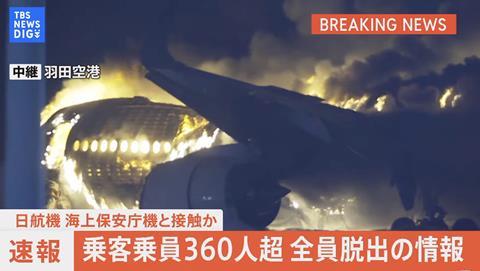The Japan Coast Guard turboprop that collided with a Japan Airlines Airbus A350-900 at Tokyo’s Haneda airport had been asked to hold short of the runway, and did not receive permission to take off by air traffic controllers, according to a transcript released by Japanese officials.
The transcript, a copy of which was seen by FlightGlobal, appears to differ from an earlier account by the pilot of the De Havilland Canada Dash 8, who reportedly said he was given permission to depart.

The collision on 2 January left five Coast Guard crew members dead, and both aircraft completely destroyed. All 379 passengers and crew on the JAL widebody jet successfully evacuated the burning aircraft.
According to the transcript, the crew of the Dash 8 had acknowledged air traffic control instructions to taxi to holding point C5 – adjacent to Runway 34R – at around 17:45 local time.
The turboprop was bound for Niigata to delivery supplies to those affected by a major earthquake in Japan’s northwest region.
The transcript also shows that the confirmation from the turboprop’s crew came nearly 20s after air traffic controllers gave the JAL A350, which was operating as flight JL516 from Sapporo, clearance to land on Runway 34R.
Less than two minutes later the collision occurred as the A350 landed.
A day after the accident, JAL said it believed the A350 had received the go ahead to land at Runway 34R, based on preliminary interviews with the flight crew. The latest transcript from Japan’s transport ministry appears to corroborate this.
FlightGlobal reported on 2 January that Haneda was operating in mixed mode – with both departures and arrivals on the same runway – at the time of the collision.
Investigations into the accident are ongoing, led by Japan’s Transport Safety Board. They are being assisted by their counterparts from France, as well as representatives from Airbus.
The incident is the first hull loss involving the A350 since it entered service almost exactly nine years ago.
JAL took delivery of the A350 (JA13XJ, MSN53) in November 2021, while the Dash 8 (JA722A) was delivered to the Japan Coast Guard in 2009.
Separately, JAL has said it is studying closely the financial impact of the accident on its full-year earnings. In a stock exchange filing on 4 January, the Oneworld carrier says it will incur a loss of Y15 billion ($105 million) from the accident, which will be booked as operating losses and covered by insurance.


























